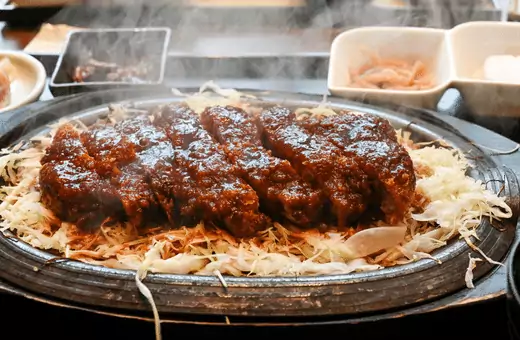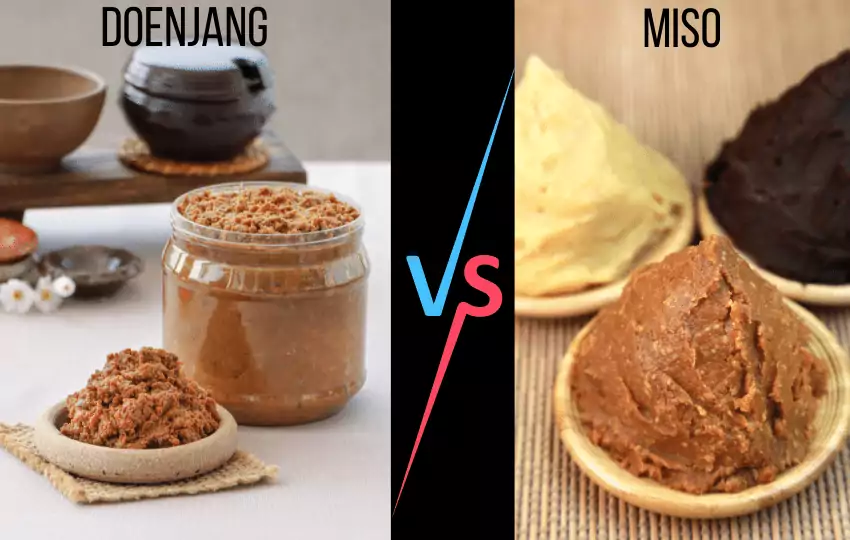Miso and Doenjang are both popular fermented soybean pastes that can be used as a flavoring in many Asian dishes.
They share some similarities, but they also have some key differences. Miso is also typically less salty than doenjang. Doenjang has a more intense flavor and a saltier taste.
In this post, we’ll take a closer look at the 8 major differences between doenjang VS miso, so you can decide which one is right for you.
If you’re in hurry then take a quick look at the differences between miso paste and doenjang
A Quick Table: Miso VS Doenjang
| Difference | Miso | Doenjang |
|---|---|---|
| Origin | Japan | Korea |
| Texture | Smooth creamy paste | Chunky texture |
| Taste | Rich umami | More intense than miso |
| Look | Ligh color than Doenjang | Darker than Miso |
| Main ingredients | Fermented soybean paste, Koji, Rice, barley | Fermented soybean paste, brine, ground anchovies, |
| Fermented Time | 2 to 5 weeks | less than miso |
| Available | Red, white, yellow, and black hue, also in powder form | Reddish to dark brown hue paste |
| Main use | Miso soup, Dashi soup, udon | Ssambap, grill pork, bibimbap, bulgogi |
How is doenjang distinct from miso?- Doenjang VS Miso
Origin- Miso paste vs Doenjang
Doenjang originated from Korea, whereas miso originated from Japan.
Main Ingredients
Doenjang is mainly made of fermented soybean paste, and brine also adds soup soy sauce. Now, also add fermented, dried, and ground anchovies.
Miso is made of salt, koji, which is Aspergillus oryzae, a fungus, and fermenting soybeans. Additionally, also add seaweed, rice, and barley for a more intense flavor.
Taste- Doenjang VS Miso paste
Both have an umami taste, but doenjang is saltier than miso; miso has a sweet, savory aftertaste.
Appearance- Korean Soybean paste vs Japanese Soybean paste
Doenjang has dark color than miso due to soy sauce. Miso paste is also available in white color, which is known as white miso.
Texture
Doenjang has a chunky texture, whereas miso has a smooth creamy peanut-like paste consistency.
Nutritional Facts
Doenjang has a high amount of flavonoids and plenty of essential amino acids such as lysine, minerals, and vitamins.
Miso has a high amount of vitamin B12, vitamins, and minerals.
Types- Miso vs Doenjang
Depending on the fermentation process and ingredients, miso comes in three types: red miso, white miso, and mixed miso.
Also available in various flavors such as rice, barley, soybean, red, more umami, and so on.
On the other hand, Doenjang has two types depending on the brine amount- Tojang (aged brine is boiled and mixed) and Jangjae (A smaller amount of brine is used).
Main Usage- Miso and Doenjang
The main use of Doenjang is seasoning and dipping condiments. Doenjang is the key ingredient of ssambap, a South Korean unique dish.
Ssambap is wrapping different items such as beef, pork, garlic, kimchi, green pepper, and onions into a perula leaf or lettuce leaf.
Doenjang also has key components of as samgyeopsal (grilled pork belly), bulgogi (marinated fried meat), bibimbap (Korean fried rice), and bossam (pork dish).
The main use of miso is Miso soup, a popular staple food in Japanese cuisine. It is also added to various soupy dishes like Imoni (Japanese meat soup), Ramen (noodles dish), Udon (Thick noodles soup), and Nabe (Japanese hot pot dishes).
Sweet miso also adds traditional confections like Mochi (Sweet Rice cake)and Dango (Japanese sweet dumplings).
Besides this, miso also used various savory dishes, making pickles, etc.
When should you use miso, and when doenjang?
The right choice of fermented soybean paste will vary depending on the dish you are preparing and your personal preferences.
However, doenjang is generally good for heartier dishes such as stews. At the same time, miso is ideal for soup or lighter fare.
Ultimately, the best way to decide which paste to use is to experiment and see what you like best!
So, now you may want to know…
Is Korean doenjang the same as Japanese miso?
Yes, Doenjang is not exactly the same as miso. Still, it bears many similarities in tastes and appearance but also some significant differences.

Doenjang is made with soybeans and brine that have been fermented and then mashed into a paste. In contrast, miso is made with soybeans and koji that have been fermented and then cooked into a paste.
The fermentation process for doenjang is usually longer than for miso, which gives it a more intense flavor.
Doenjang is also typically darker in color than miso. Doenjang is usually used as a condiment or dipping sauce, while miso is often used as an ingredient in soups and other dishes.
Can you use Korean soybean paste for miso soup?
Yes, you can use Korean soybean paste for making miso soup. The flavor will be slightly different from traditional Japanese miso soup, but it will still be delicious.
Know more- 17 Best Miso paste substitutes| Vegan, soy-free and gluten-free
Can you replace soybean paste for miso?
Miso is a fermented soybean paste that is used in many Japanese dishes. While you can substitute soybean paste for miso, it will not have the same flavor.
Miso is made with fermented soybeans, rice, koji, and salt, while soybean paste is made with boiled soybeans and salt. The fermentation process gives miso its distinct flavor. Suppose you are looking for a substitution for miso.
In that case, you can try using other fermented soybean paste, soy sauce, or tamari.
Doenjang vs miso substitute
Doenjang is a Korean soybean paste that is used as a seasoning or as a dip. Miso is a Japanese soybean paste used as a seasoning or dip.
They are both made from soybeans, but they have different flavors. Some say that doenjang has a stronger flavor than miso and that miso is sweeter than doenjang.
If you can’t find doenjang, you can substitute miso in recipes. Just make sure to use the same amount of miso as the recipe calls for doenjang.
Doenjang can be used in many dishes, such as stews, soups, and marinades. It is also a common ingredient in Korean kimchi. If you are looking for a doenjang recipe, you can try this one for doenjang jjigae (Korean soybean paste stew).
Miso can also be used in many dishes, such as soups, sauces, and marinades. It is also a common ingredient in Japanese sushi. If you are looking for a miso recipe, you can try this one for miso soup.
Doenjang and miso are both essential ingredients in Korean and Japanese cuisine. If you want to try something new, why not give them a try? You might be amazed at how much you like them!
Read More- Teriyaki sauce VS Korean BBQ sauce
Bottom Line: What is the difference between miso and doenjang?
Doenjang and miso are both great options for savory, umami-packed flavors in your cooking. They can be used interchangeably in most recipes, so it really comes down to personal preference.
Doenjang is typically made with soybeans and barley, while miso is usually made with soybeans and rice. Both are fermented foods that are high in protein and low in calories. So which one is best for you? Try them both and see!

